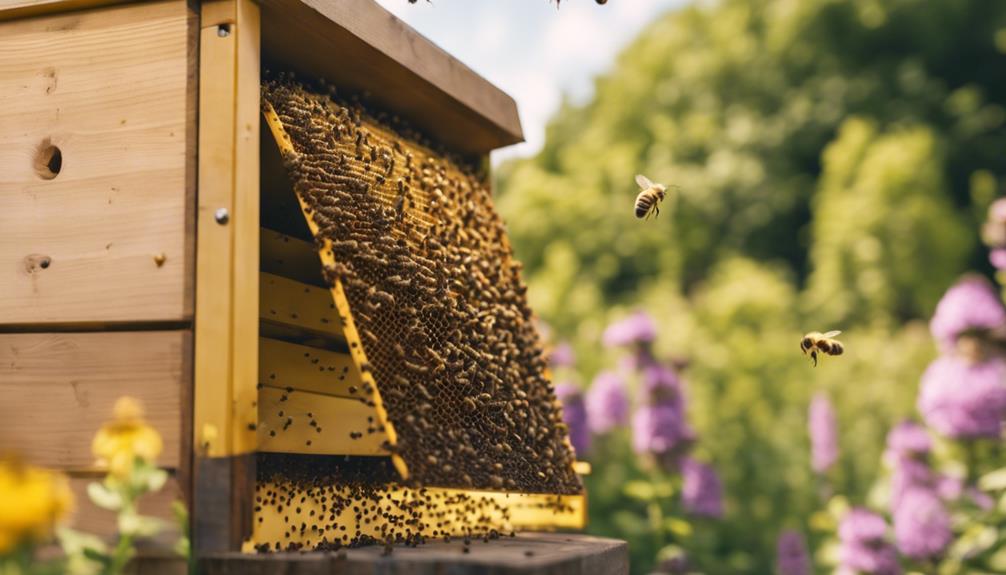Knowing when to remove an entrance reducer is essential for hive ventilation and bee well-being. A bustling entrance with bees bringing in pollen and nectar indicates a strong colony that may benefit from increased airflow. During peak nectar flow, strong hives thrive with fully open entrances, while weaker ones may require adjustments to boost productivity. It’s important to monitor hive strength, colony activity, and resource abundance to make informed decisions. Considering factors like weather conditions and colony health before making adjustments guarantees ideal conditions for your bees. Making the right call on entrance reducer removal can significantly impact your hive’s vitality.
Main Points
- Assess colony strength and nectar flow before removing the entrance reducer.
- Monitor bee activity to determine if the hive is strong and needs full access.
- Consider weather conditions and hive congestion when deciding on removal.
- Support weaker colonies by keeping the reducer until they grow stronger.
- Regular inspections help evaluate when to remove the entrance reducer for optimal ventilation.
Importance of Adequate Hive Ventilation
Ensuring proper hive ventilation is essential for maintaining healthy bees and effective hive management. Bees are like us; they crave fresh air and a comfortable environment. Adequate airflow through the hive entrance is how they keep things just right.
Monitoring their activity helps us decide when it’s time to adjust or remove the entrance reducer. By doing so, we can improve ventilation and prevent overheating, ensuring our bees live their best lives. Mold and stress will be a thing of the past with good ventilation.
Signs of a Strong Colony
A busy hive entrance bustling with activity signals a strong colony. When we see bees coming and going, carrying nectar and pollen, it’s a sure sign that our hive is thriving. Inside, the frames are packed with brood and food stores, showing a healthy and productive population.
These bees aren’t just working hard; they’re also vigilant in defending their hives. Their increased activity and ability to protect the colony indicate strength and resilience. With abundant resources being brought in, it might be time to contemplate removing the entrance reducer to allow for smoother traffic flow.
Observing these indicators lets us know that our bees are in good shape and ready to make the most of the peak nectar flow ahead.
Peak Nectar Flow Considerations
During peak nectar flow, it becomes essential to assess and adjust entrance reducers to optimize bee foraging efficiency and colony productivity. As nectar becomes more available, strong and populous colonies thrive with a fully open entrance, accommodating their increased workforce. These colonies benefit greatly from unrestricted access during this period, allowing them to make the most of the abundant resources.
For weaker colonies, the influx of nectar can prompt rapid expansion, necessitating the removal or enlargement of entrance reducers to support their growth. By adjusting entrance reducers based on colony strength and nectar availability, beekeepers can help improve hive defense mechanisms and boost overall bee productivity.
Timing for Weaker Hives
Optimizing hive management involves timely consideration of entrance reducer removal for weaker colonies, ensuring their protection and resource management until they strengthen. We need to monitor hive strength and nectar abundance closely to determine the right moment to remove the entrance reducers.
It’s vital not to remove them too early as weaker hives rely on these reducers for safety and efficient resource regulation. By keeping the entrance reducers in place until the colony is stronger, we protect weaker colonies from potential threats and help them regulate resources effectively.
This strategy supports the hive’s growth, allowing them to thrive when the timing is just right. So, let’s be patient and observant, giving our weaker hives the support they need until they can stand strong on their own.
Colony Health Assessment and Adjustments
When evaluating colony health and making adjustments, it’s crucial to observe bee traffic and activity at the hive entrance. Monitoring for signs of congestion or bottlenecking can indicate if the wooden entrance reducers need to be removed. A smaller entrance makes it easier for bees to defend the hive but can lead to issues if the colony outgrows the space.
Evaluating colony strength through regular inspections is vital. Before deciding to remove the reducers, evaluate weather conditions and nectar availability. Adequate ventilation is key for the bees’ well-being. So, keep an eye on the hive’s overall health and make adjustments as needed to ensure the colony thrives.
Roger Thomas is a seasoned beekeeper and hive architect with a deep-seated passion for sustainable living. His fascination with bees has shaped his professional career, giving him practical and theoretical expertise in bee behavior, colony health, and optimal hive conditions. Roger’s technical skills shine in his bespoke hive creations that cater to the specific needs of diverse bee species, while his sustainable practices promote environmental balance and the wellbeing of the bee population.
As he continues his journey in beekeeping, Roger has become a dedicated advocate for responsible practices and an insightful educator in his field. His posts aim to inspire new beekeepers, underline the importance of sustainability, and showcase the remarkable contribution bees make to our ecosystem. Roger invites you to join him as he delves into the world of bees and the rewarding, honey-sweet art of beekeeping.

